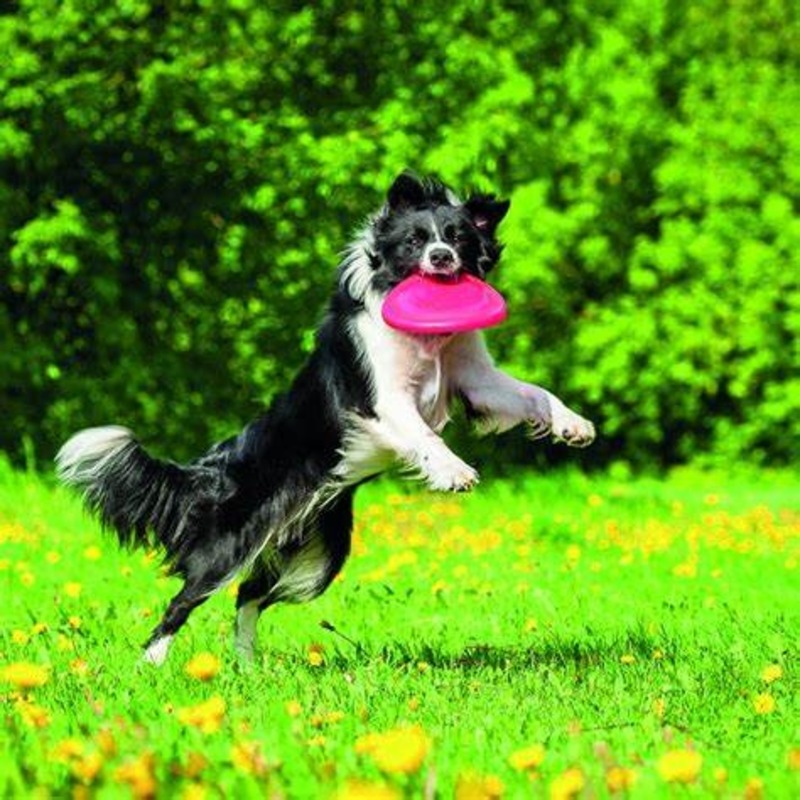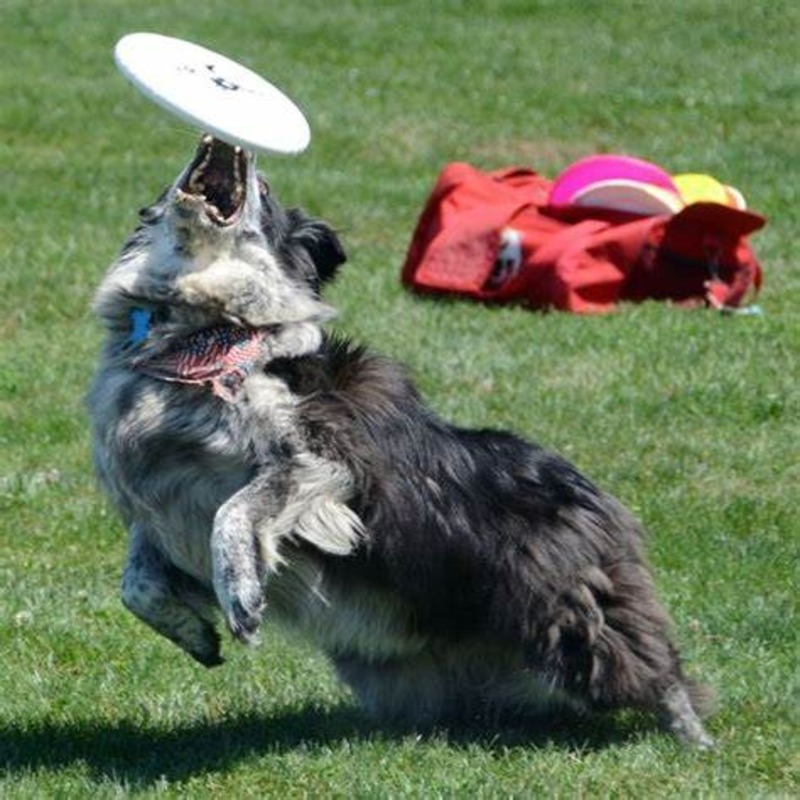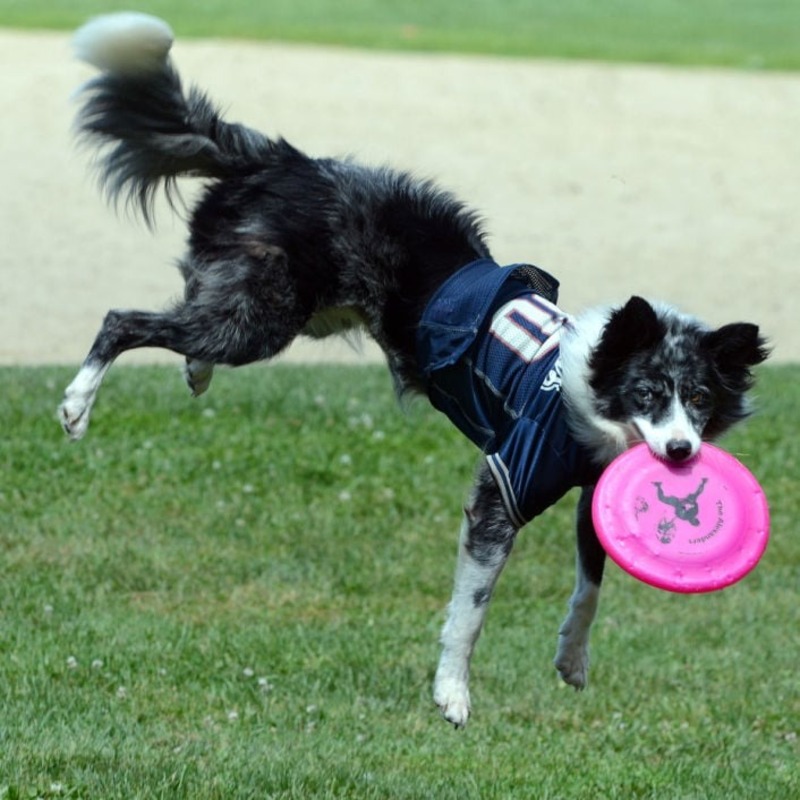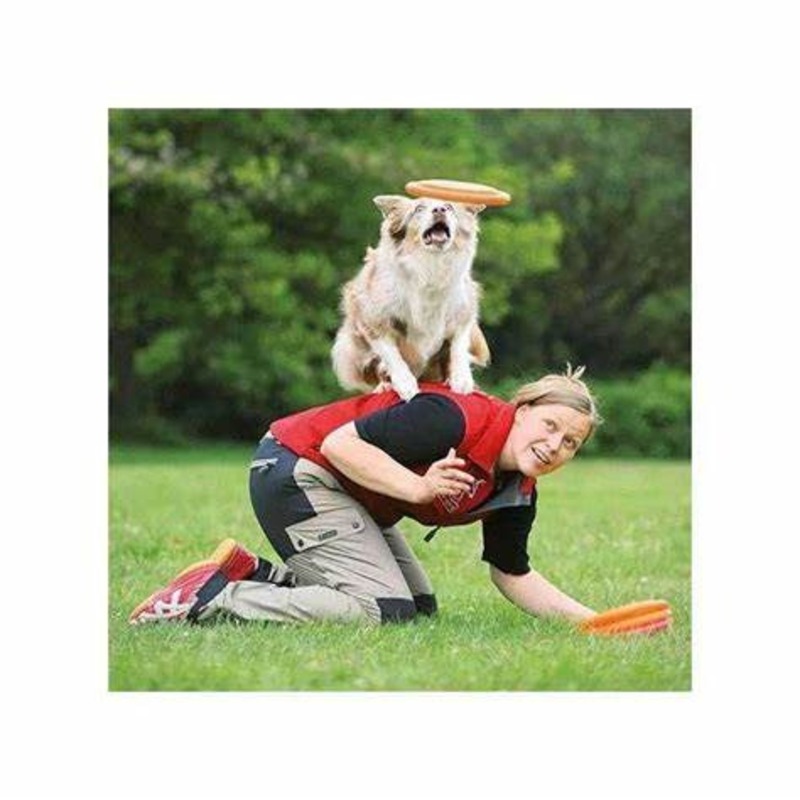Preparing Your Dog for Frisbee Competitions
To excel in dog frisbee competition, preparation is key. Your dog must be ready physically and mentally. Below are vital steps to prepare your dog for these exciting events.
Choosing the Right Frisbee
The right frisbee makes a difference. Look for one that’s durable, the correct size, and easy for your dog to grip. Lightweight and soft frisbees are ideal for preventing injury. Some frisbees are designed for distance, while others are for tricks. Choose based on your competition goals.
Building Stamina and Strength
A fit dog can compete at its best. Start with regular runs and playful activities to build endurance. Add in swimming or fetch sessions for strength. Gradually increase the intensity and duration as your dog’s fitness improves. Always monitor your dog and ensure they enjoy the training.
Teaching Advanced Frisbee Tricks
Advanced tricks can earn high scores. Begin with basic throws and catches. Once mastered, move on to more complex maneuvers. Tricks like overs, weaves, and vaults impress judges. Practice these regularly and always reward your dog for their hard work. Consistent practice with positive reinforcement will make your dog a top contender.

Understanding the Rules of Dog Frisbee Competitions
A good grasp of competition rules ensures a smooth experience. Knowing the rules helps avoid penalties and boosts the chance of winning.
Competition Categories
Dog frisbee competitions may have various categories. These typically include toss and fetch, freestyle, and mixed. Toss and fetch focus on throwing distance and accuracy. Freestyle tests creativity and trick combination. Mixed combines both elements. Select the category that best suits your teamwork and skills.
Scoring Criteria
Judges rate performances on several factors. These often include the number of successful catches, the distance of throws, and the difficulty of tricks. Teams also earn points for dog athleticism and handler performance. Review and understand the scoring criteria before competing.
Common Fouls to Avoid
Fouls can lead to point reductions or disqualification. Common fouls include frisbees thrown out of bounds, drops, and unsafe plays. Always maintain control and safety during routines. Prepare by knowing the fouls and training your dog to avoid them.
Training Tips for Competitive Frisbee Dogs
Success in dog frisbee competitions stems from solid training practices. A well-crafted training regimen elevates a dog’s performance. Follow these crucial tips to hone your dog’s frisbee skills to competition level.
Developing a Training Schedule
Create a structured training schedule that suits your dog’s needs and your lifestyle. Consistency is key; set specific days and times for practice. Balancing frisbee training with rest and other activities prevents overtraining. Start with shorter sessions and increase as your dog builds stamina.
Mental and Physical Warm-Ups
Always begin with warm-ups to avoid injuries. Start with simple stretches for your dog and a brisk walk. Mental warm-ups can include basic commands to engage your dog’s focus. This prepares them both mentally and physically for the training session ahead.
Importance of Consistent Practice
Regular practice is essential for mastering frisbee skills. Aim for daily short sessions rather than sporadic, longer ones. This regularity helps reinforce skills and improves your dog’s muscle memory. Mix up routines to keep your dog engaged and challenged. Praise their effort to boost their motivation and spirits.
Essential Frisbee Throws for Competition Success
To shine in dog frisbee competition, you need a strong arsenal of throws. These throws form the foundation of your performance and can influence your score.
The Backhand Toss
The backhand toss is a fundamental throw every competitor must master. It’s reliable and easy to control. Hold the frisbee with a firm grip, and flick your wrist as you release it. This throw works well for accuracy and is a favorite in toss and fetch categories.
The Sidearm Throw
For a faster and more challenging catch, the sidearm throw is essential. It requires you to snap your forearm during release, sending the frisbee spinning on a horizontal plane. This throw covers great distances quickly, perfect for testing your dog’s speed and agility.
Adding Variety with Specialty Throws
Specialty throws add flair to your routine and captivate judges. These include behind-the-back, under-the-leg, and over-the-shoulder throws. Each throw demands practice and timing to perfect. Use them to showcase creativity and elevate your freestyle performance in a dog frisbee competition.

Nutrition and Health Management for Athletic Dogs
Proper nutrition and health management are crucial for dogs participating in frisbee competitions. These athletic dogs need a balanced diet and routine care to maintain peak performance.
Diet Considerations
Feeding your dog the right food before a dog frisbee competition can greatly affect their energy and performance. Look for high-quality, protein-rich foods that will provide sustained energy. Include healthy fats for endurance and carbohydrates for quick energy. Stay consistent with meal times and amounts to avoid digestive upset. Hydration is equally vital, so ensure fresh water is available at all times.
Injury Prevention and Recovery
Injuries can set back training and competition performance. To prevent injuries, ensure your dog has proper warm-up and cool-down routines. Employ stretches and massages that can prevent muscle strains. If an injury occurs, consult your vet promptly for treatment plans. Allowing ample time for recovery is key to your dog’s long-term health and competitive abilities.
Routine Health Check-Ups
Regular vet check-ups are a cornerstone of maintaining an athletic dog’s health. These should include checks on heart health, joint mobility, and overall fitness. Vaccinations and parasite control are also essential. A vet can provide tailored advice on nutrition, exercise, and injury management. Timely vet visits help catch potential issues early, ensuring your dog is always ready for competition.
Selection and Conditioning of a Frisbee Dog
When entering the world of dog frisbee competition, picking the right canine partner is pivotal. The breed’s natural characteristics and athleticism weigh heavily on their potential to excel.
Breed Characteristics and Athleticism
Some breeds display natural traits ideal for frisbee competitions. These breeds often include Border Collies, Australian Shepherds, and Whippets. Look for agility, speed, and a propensity for catching frisbees in the breed’s makeup. Not every dog within these breeds will suit, so observe individual tendencies towards athletic pursuits.
Temperament and Trainability
A good frisbee dog displays not just athleticism but also a trainable temperament. They should be eager to learn, responsive, and have good concentration. Positive reinforcement enhances trainability. Opt for a dog that shows enthusiasm for playing with frisbees and is able to focus amid distractions.
Conditioning Exercises for Your Dog
To prepare your dog for a dog frisbee competition, engage them in conditioning exercises. Start with basic agility training like jumps and tunnels. Add exercises like zig-zag runs and sprints to boost speed and coordination. Adjust intensity to prevent strain and fatigue. A fit dog performs better and is less prone to injury.
Strategies for Bonding and Teamwork
Succeeding in dog frisbee competitions isn’t only about physical skill. It also hinges on the bond and teamwork between you and your canine partner. Building a strong relationship is at the core of your success in these events.
Building Trust with Your Dog
Trust is the foundation of any great team. Start by spending quality time with your dog beyond training sessions. Engage in activities your dog enjoys to strengthen your bond. Be consistent with your commands and rewards to build a reliable communication channel. A dog that trusts its handler is more responsive and performs better in a stressful competition environment.
Understanding Dog Body Language
Dogs communicate mostly through body language. Learn to read your dog’s signals. Observe their posture, tail movement, and ear positions during different situations. This can tell you if they are stressed, excited, or focused. Recognizing these cues helps you adjust training methods and provide comfort when necessary. It also aids in preempting any potential issues during a competition.
Enhancing Communication During Competition
Clear communication is essential, especially in the heat of a competition. Develop hand signals and verbal cues that your dog readily understands. Practice these in various settings to ensure your dog can follow them despite distractions. Good communication allows for smooth execution of routines and can make the difference in a tight contest.

Doing well in dog frisbee competitions involves more than training. It includes smart planning and mental readiness.
Pre-Competition Preparation
Preparation before the event sets the stage for success. Ensure your dog is well-rested and stress-free. Check the competition venue beforehand, if possible. This helps your dog get comfortable with the environment. Lay out all gear the night before. This includes the frisbee, water, and any treats or rewards. Plan your arrival to allow enough time for a calm, focused warm-up.
Handling Competition Pressure
Competition brings stress, both for you and your dog. Stay calm and confident; your dog can sense your emotions. Keep routines normal on the day to minimize anxiety. Use deep breaths and positive self-talk to manage your nerves. Stay present and focus on one throw, one catch at a time.
Post-Competition Analysis and Feedback
Reflecting after the event is crucial for growth. Note what went well and areas for improvement. Seek constructive criticism from judges or fellow competitors. Celebrate your team’s achievements, no matter how small. Use feedback to adjust training and prep for the next dog frisbee competition.
